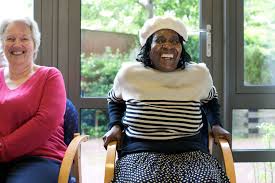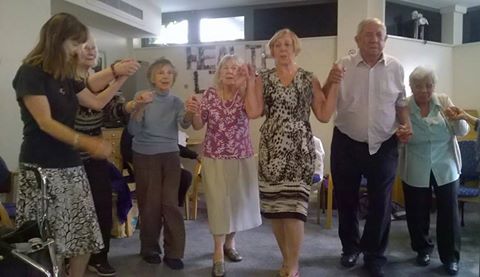 I arrived at Lambeth’s Healthy Living Club at the same time as 75-year-old William. He couldn’t find his wallet to pay for his transport. No matter, Dave Bell, a volunteer, was on hand to lend him the money. Later I saw Dave making sure that William, who has dementia, was okay to get home. Before I’d even set foot in the club I’d seen its values in action.
I arrived at Lambeth’s Healthy Living Club at the same time as 75-year-old William. He couldn’t find his wallet to pay for his transport. No matter, Dave Bell, a volunteer, was on hand to lend him the money. Later I saw Dave making sure that William, who has dementia, was okay to get home. Before I’d even set foot in the club I’d seen its values in action.
For this is not somewhere that “provides care”; there are no carers and cared for, no them and us, and certainly (thank goodness) no service users. Instead, I met a group of people who have gradually evolved into a community and become friends. At their heart is a slight, Italian woman with curly jet black hair, a vision and a fierce determination. She’s called Simona Florio and I’ll return to her later.
The club is more like a series of parties where forty to fifty people – most of whom have dementia or care for someone who does, and who are as varied in their ages, culture and ethnicity as Lambeth itself – come together every Wednesday at Lingham Court, an extra care housing complex. Here they enjoy home-made lunch cooked on the premises, singing and music, a bit of impromptu dancing if it takes their fancy, quizzes, poetry and – I can vouch for this – a jolly good laugh.
Soon after I arrive 38-year-old Laurent Mendy takes a seated exercise class. His energy matches Simona’s and the Frenchman tells me he looks forward to Wednesdays because they’re much more fun than his normal work for corporate clients. “You fall in love with them,” he says of the Lambeth group.
His words echo those of resident musician Melanie Jones. “It’s a great joy for me being here. Everyone is always willing to give things a go and there is a quite unique level of optimism”.
Shelley Russell, who has been volunteering at the club for two years, says she puts everything behind her when she comes to the club “and just gives out love – it’s like coming to see old friends”.
I’m beginning to wonder who the real beneficiaries are here, but then I remember that this is the whole point. “We are a community of individuals who help each other when we meet,” says Simona, “but our motivation for meeting is not to provide or receive care. Therefore we are not care providers, and it is this that makes the Healthy Living Club a model of self-care”. And therein, she might add, lies its secret.
Ann Fitzgerald, 78, has been coming with her 79-year-old husband Patrick for about two years. She tells me that she and Patrick used to dance, go to the theatre and play bowls, but when he was diagnosed with dementia they were suddenly cut off.
“It was very lonely. When we come to the club people welcome us and make us feel worth something. It’s a very warm feeling and so important because otherwise we feel isolated”.
The story of how the Healthy Living Club came about is one of triumph over adversity, of something wonderful being born from the ashes of loss. Its plot reveals what can be achieved when humans come together – not with labels and demarcation lines, but as individuals who look out for each other – and its author (though she would never say so) is Simona.
The tale began in February 2012 when it was announced that Lambeth’s Healthy Ageing Café, run by the Alzheimer’s Society and funded by the local primary care trust, was to be closed. There were, says Simona (who was its co-ordinator at the time) “floods of tears”. For many of those who attended, the café was their only source of social contact; they described it as their lifeline.
They weren’t the only ones upset at the café’s closure, so too were its volunteers and the Lingham Court residents, some of whom attended, and still do (including 101-year-old Edna, who I met when I visited).
It was Simona who realised that the group didn’t need to be comprised of “service users” and “service providers” to continue, they could simply meet because they wanted to. “I knew that it wouldn’t be an easy ride and that I would have to do a lot of unpaid work and even build up some personal debt,” she says. “But I had to find a way to keep the project going; I just couldn’t let down all those people or the spirit that united us”.
And so, on 4 April 2012, the Healthy Ageing Café was reborn as the Healthy Living Club. Its continued running has unearthed hidden talents in its members who, led by Simona, have established it as a charity, promoted it on social media and submitted bids for funding.
 A few days after my Lambeth visit I attended something altogether different: a seminar on improving care for older people, where speakers included some of the big guns in the sector.
A few days after my Lambeth visit I attended something altogether different: a seminar on improving care for older people, where speakers included some of the big guns in the sector.
It focussed largely on the integration of health and social care. What really interested me was the suggestion (made more than once) that this aim could only be realised through a small-scale, bottom-up approach, not a large, top-down one. I’ve been saying this to anyone who will listen for quite a while now because, in the course of my writing, I’m lucky enough to encounter numerous examples of small, grassroots enterprises that showcase the very best of dementia care.
Truly person-centred, co-ordinated care (which, incidentally, is how Andrea Sutcliffe of the Care Quality Commission told the seminar she prefers to talk of integration) has, almost by definition, to be small-scale, flexible, tailored to the individual.
Nowhere is this more true than for people with dementia and their carers; nowhere is it better illustrated than at the Healthy Living Club.
In this film for the Health Innovation Network, Dave Bell, who is also an Admiral Nurse (a specialist dementia nurse, focussing on the needs of carers of those with dementia), outlines what the club does and unwittingly gives a wonderfully human description of the Holy Grail that is integrated health and social care.
 “If there was no Healthy Living Club,” he says, “there would be a greater reliance on statutory services such as GPs, A & E and social services. The club provides a level of activities, social contact and stimulation that creates, like a ship, a wake of well-being”.
“If there was no Healthy Living Club,” he says, “there would be a greater reliance on statutory services such as GPs, A & E and social services. The club provides a level of activities, social contact and stimulation that creates, like a ship, a wake of well-being”.
It’s a wonderful image with the added benefit of being true. The club has caught the eye of others, such as the College of Medicine and the Social Care Institute for Excellence, who are far more knowledgeable about such things than me, and their reports (on the club’s excellent website) validate Dave’s words and are well worth reading.
There’s no doubt that a little bit of magic happens once a week down Lambeth way. It’s sprinkled with the sweat and tears of Simona, a pocket-rocket-fuelled inspiration of a woman. If you’d like the magic to continue and the music to play on, please vote here.
In doing so you will be helping to ensure that Melanie’s rhythm and percussion sessions don’t fall silent when the current funding runs out – and with just two or three clicks of your mouse, contributing to something very special indeed.




Beautifully written. Voted! x
Thank you so much Lisa. These guys are absolutely brilliant; they really are. And so deserving.
Remarkable project deserves support. Voted
Brilliant, thanks Jason. They are remarkable and your vote will be much appreciated.
Voted! Love your blog and the project.
Thanks Rachel!
This bring holistic development of the elderly socially, psychologically, physically, emotionally stimulate functioning.It bring support among them. Group dynamics when followed up merits of group can be acheived
What a unbelievable set of Special ppl……… it just shows what can be done just by having load of Empathy and Human Spirit.
Yes. They are special and I am a great believer in the best dementia care actually being little more than people showing humanity to each other. Thanks Julie.